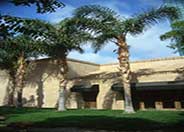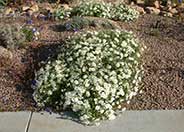
Common name:Queen Palm
Botanical name:Syagrus romanzoffianum
This palm has a very straight trunk to about 50' in height. It has arching, feathery, bright green, glossy leaves that can be 10'-15' long. It is fragile in heavy winds and a fast grower. It will become damaged in temperature below 24 degrees F.

Common name:Hidcote English Lavender
Botanical name:Lavandula angustifolia 'Hidcote'
This is a slow growing lavender that grows to 2-3' tall with deep purple flowers. It is drought tolerant and attracts hummingbirds and butterflies.
Maintenance Tips
Lavandula angustifolia 'Hidcote' is a smaller hybrid of the English Lavender and is often found in California native gardens. It is a woody shrub with a nice round form. It grows 2-3’ tall and wide and has flower stalks that emerge above the foliage in the spring. The foliage and blooms are very fragrant and are a magnet for bees and butterflies. To keep the maintenance as low as possible, plant it in a sunny location with the space to reach its full mature size. Once the flowers have faded, the spent stalks can be deadheaded to keep the shrub looking tidy and encourage additional flowers. This shrub can take a more aggressive hedging, cutting back by about a third in the winter to keep the round shape.
Common name:Mexican Bush Sage
Botanical name:Salvia leucantha
The Mexican Sage is a bushy shrub that grows 3'-4' tall and wide. It has hairy white stems, gray green leaves and velvet-like purple flower spikes that bloom summer through fall. This shrub tolerates sun, light shade, little water, and is hardy to 15 degrees F. The Mexican Sage is drought tolerant and attracts hummingbirds.

Common name:Silver Mound Artemisia
Botanical name:Artemisia schmidtiana 'Silver Mound'
This mounding perennial will grow 1'-3' high and has medium-sized silvery white leaves with yellow and white flowers.

Common name:Blackfoot Daisy
Botanical name:Melampodium leucanthum
Small mounding perennial grows quickly to 1' x 2'. White daisylike flowers with yellow centers cover the plant nearly year-round The leaves are narrow and gray-green. Accepts full sun or partial shade but blooms better in the sun. Bright and colorful groundcover. Plant in well-drained soil. Native to the southwest U.S. and Mexico.
Maintenance Tips
Melampodium leucanthum or the Blackfoot Daisy, is a small herbaceous perennial that reaches 12 – 18" tall and wide. It is very drought and heat-tolerant and requires very little maintenance to look and perform its best. Once the plant is established, it requires very little water, but it does tend to have a much longer blooming cycle if it is offered supplemental water during the spring and summer. It is very attractive to birds, butterflies, and bees and is usually pest-free. As an herbaceous perennial, it can be attractive to aphids and other soft-bodied insects that can damage the foliage. Instead of using pesticides to control these pests, it would be better to use a hard jet of water or even bring in ladybugs to treat the infestation. That will ensure the beneficial insects and birds can continue to enjoy the flowers.
Common name:Butterfly-Iris, Fortnight Lily
Botanical name:Dietes iridioides
This clumping evergreen Iris bears tall, narrow leaves to 30" tall and white flowers marked purple in the center on stalks up to 3' tall. This variety has stiffer, darker foliage than the bicolor form. It requires sun to part shade with little or no summer watering when established.
Designer: Rob Moore
Photographer: GardenSoft
Physical weed control, including mulching, or hand removal protects the watershed from harmful chemicals.
Mulching and adding compost to soil can minimize evaporation and help soil absorb and store water.
Drip and other smart irrigation delivers water directly to roots, allowing no excess water for weeds.